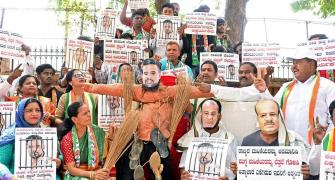Astyuttarasyaam dishi devataatmaa
Himaalayo naama nagaadhiraajah.
Puuravaaparau toyanidhii vagaahya
Sthith parvitivyaaiava maanadandaha.
Himalayas, the king of kings in the north,
is the soul of the Gods.
It extends from East to West
and is the pride of the Earth. -- Kalidas in Kumarasambhava
(3rd century AD)
The hills are alive with the sounds of chipping, chiselling, clamping and all that goes into house building. A quaint cottage near Ranikhet, a bungalow in the pristine apple and pine paradise of Mashobra, a chalet among the tea leaves of the Dooars, are just a handful of dreams a few have been able to live up to. But living your dream is not a Himalayan task anymore.
Ask Rajan Sastri, head of research & advisory, indiaproperties.com, and pat comes the reply: "Many people want to acquire property in the Himalayan belt owing to rising disposable incomes. Purchasing property in the hills serves as a holiday home-cum-investment."
Consider your hill investment as a separate asset class. Over the last year, while equity funds have yielded 54 per cent return, real estate in general, about 30 per cent and gold 8 per cent, your Himalayan abode could well have appreciated 100 per cent. That is, if buying property is legal in that state. Many Himalayan states such as Jammu and Kashmir, Sikkim, Arunachal Pradesh and parts of Himachal Pradesh and Uttaranchal have laws that prevent non-domiciles from acquiring property.
Apart from the legal right to own land, you need to establish a comfort level with drinking water facilities and the sewerage systems. Sastri warns that a lot of hill properties have septic tanks, which are not connected to the civic sewage system.
Uttaranchal Unplugged
In the 'land of the Gods', the Garhwal Himalayas make up the western half of the state and the Kumaon belt laps up the rest. Since Uttaranchal became a separate state in 2000, areas in and around the capital Dehradun have witnessed steady demand. According to Dehradun-based property dealer Jaswant Singh Rana, in adjacent Rishikesh, land is available today in the range of Rs 5-20 lakh* a bigha (thats about 17,424 sq ft).
There is a problem though. A Supreme Court order has banned any new construction in Mussorie, 32 km uphill from Dehradun. Moreover, there are about 400 estates in Mussorie, of which 216 are notified forest areas. Under forest conservation laws, no new construction can take place and neither can trees be cut in these notified forest areas.
However, around Mussorie, opportunities abound. A 2,236-sq ft four-bedroom cottage on Kempty Road is going for Rs 17 lakh. Similarly, a 1,100-sq ft two-bedroom flat, with drawing and dining, near the famous Clarke Hotel in Mussorie is all yours for Rs 22 lakh.
Rana points to the Sahastradhara Road in Dehradun where he claims prices vary from Rs 8-35 lakh a bigha. And in the new growing areas at the periphery of the city, such as Saharanpur Road, Chakrata Road and Sela Qui, land can be bought for Rs 8-10 lakh a bigha.
Properties in Kumaon have also kept pace with neighbouring Garhwal. Like Mussorie, no new construction is allowed in Nainital. "But outside town, land is available for Rs 3-4 lakh a nalli (2,163 sq ft) and in areas around Kausani, Ranikhet and Almora, the cost is around Rs 2 lakh a nalli," claims Ganesh Bhatt, promoter of the Haldwani-based Rock Link Properties and Developers. Open land around Pithoragarh is cheaper at about Rs 1.5 lakh a nalli, he adds.
In the terai region of Ramnagar adjoining Corbett National Park, land values are in the range of Rs 80-300 per sq ft, says Suyash Bansal, Partner, Agrawal Colonisers, Haldwani.
But if you care for a two-bedroom flat of 1,100 sq ft carpet area over a 1-nalli plot size in Ranikhet, you may have to pay anywhere between Rs 20-25 lakh.
Nainital-based lawyer Manoj Lohani explains the Additional Land Law of Uttaranchal which came into existence on September 12, 2003. "This law states that outsiders can buy property in the state up to 550 sq mt (5,914 sq ft). If property above this limit is to be acquired, one has to get the District Magistrate's permission for which one has to file an affidavit with the DM stating that land will be used only for horticulture or agriculture," says Lohani.
Anil Bisht, 34 and his wife, Pooja, 28, are a case in point. In 2002, the couple purchased 65 nallis (1.40 lakh sq ft) at Mahadev Chatti, 32 km upstream of Rishikesh, at Rs 14.3 lakh. Bisht runs an adventure camp by the Ganges, and has had to invest Rs 5 lakh for a garden with more than 300 fruit and vegetable trees. This complies with the law. Despite the property being a good 30-minute walk from the road, land prices in the vicinity have doubled in the last three years and today sit at Rs 50,000 per nalli.
Apart from the garden, the Bishts have built a 1,500-sq ft house, another 700 sq ft kitchen and a separate 700 sq ft dining hall cut from a rock face. The cost of the property, along with the value-addition, tots up to Rs 19.3 lakh. "Construction cost is cheap as local materials are used," says Bisht.
With no electricity yet, the Bishts have to eke out a Robinson Crusoe-like existence. "I want to put up huts with modern amenities by the river bank," he says. That's the reason Bisht has been scouting for power of late. He has even approached the state government and says he was asked to pay Rs 4 lakh just to drag a 2-km wire from one bank of the river to the other. "Despite the swift current in the river, there is little I can do to tap power, and although I have a waterfall right next to my house, laying a plastic pipe to use the latent power would cost upward of Rs 1 lakh," he says.
As Bisht hopes for a swift settlement for his power woes, he can't help but feel good about the loan he took from his family along with his savings to snap up the virgin turf four years ago.
Now take the case of the 43-year-old Sridhar Rajan, former software entrepreneur and a voluntary primary school teacher from Delhi. His family has a property in Majkhali, 11 km beyond Ranikhet. It is one among 14 cottages nestled on a hill slope. Rajan's mother-in-law, Dr Pradhan, had bought it in 1994 from a local property developer. "The initial plan was to create a small colony of eco-friendly buildings but when people started buying, configurations changed as they did their own modifications and our slope was saddled with some very large houses and a cluster of small houses," says Rajan.
The property stands on 3,600 sq ft of land and since there is no piped water connection, rainwater harvesting comes handy. Dr Pradhan had bought the property for Rs 9 lakh. Today, it is worth Rs 20 lakh. After a little lobbying by the neighbours, and the rough road, we learn, has been macadamized. There is power shortage but Rajan is not complaining. "We need electricity only for hot water and for the pump which can pull the water to the overhead tank. The load we get suffices."
As for the rest of Rajan's neighbours, "some use the cottages commercially and rent them out. The well-heeled have caretakers and the not-so-well-off have part-time caretakers." The family visits the cottage twice a year and Rajan senior wants to settle down there once junior's through with college.
Himachal Holdings
Himachal Pradesh (HP) perches from 350 metres to 6,975 metres in India's north. It is peaceful and well-connected with the rest of the country. Moreover, there is zero tax on dwellings up to 1,000 sq ft. And with superb infrastructure like roads and cheap power (80 paise per unit), it is an investor's paradise.
Till about a year back, investments were primarily for the purpose of getaways. Only since last year, investments for profit booking have started to take place. Sastri contends, "The restrictions on purchase are neatly circumvented by entering
into partnerships with the locals. With easing of controls, I see a lot of investments flowing into the state." HP is all
set to witness a building boom spearheaded not just by investors but by cash-rich developers.
According to Shimla-based lawyer Sandeep Mahajan, individual non-domiciled investors earlier had to get the state government's approval to invest in property, under the Himachal Tenancy Land Reform Act (1972), which required file pushing by the Cabinet. "However, built-up structures for sale in urban areas required no permission. Only in rural areas, permission was required," he explains. Processing of a file took anywhere between three months to a year. The rationale of acquiring property in the state needed to be clearly stated in the form with conditions such as agreement to sell and unambiguous titles duly certified by the revenue records. Even today, outsiders can acquire property in the state only up to 500 sq mt (5,376 sq ft) in non-urban areas. "This law is also binding for domiciled persons who are non-agriculturists," Mahajan clarifies.
In July this year, however, the state opened its doors to outsiders with HIMUDA (Himachal Pradesh Urban Development Authority) giving the necessary permission to builders for land development. Ajay Goel, Managing Director, Shimla Goel Buildwell, is one such builder. His company has already developed 1,000 flats across Shimla, Sanjauli, New Shimla and Kusumpatti. Also in the works are 700-odd flats in Mashobra, Naldehra, Chail and Shogi. "Throughout Himachal, prices today are in the range of Rs 1,500-2,500 per sq ft," Goel maintains. After the state government's nod, 170 builders have already registered with the housing board, and last heard, seven had got licences.
Housing in the state cuts across three zones. Zone A comprises the upmarket Shimla, Dalhousie and Manali; Zone B consists of Una, Palampur, Baddi and Solan; and the remote areas of Rohru and Sundernagar make up Zone C.
Gaurav Bhalla, Promoter, Milan Centre Property Developers, wants to sell a three-bedroom, 4,500-sq ft, independent bungalow in Barog for Rs 60 lakh. He bought land in Solan for Rs 4.50 lakh last year, where he built a one-bedroom apartment over 800 sq ft and is now puts its price at Rs 10 lakh. Similarly, he purchased a 1,250 sq ft semi-structure in Solan last November. With development cost of Rs 300 per sq ft, his asking price today is Rs 21 lakh.
Hillexicon Land measurements vary from state to state as local benchmarks vie to seize the day. Here's an attempt to square up local measurements Local Land Measurement Sq ft 1 Bigha 17,424 1 Nalli 2,163 1 Kanal 107,984 1 Cottah 720
Good Hill Hunting
You Can't Touch This! * 1 lakh = 100,000
Take the case of Deepak Sanan, 49, India Team Leader, Water and Sanitation Programme, World Bank. He bought a 1.5 acre (65,340.6 sq ft) plot 4 km beyond Mashobra. Being an IAS officer from the HP cadre, getting the government's nod was easier for Sanan, who received permission to use the patch for horticulture and agriculture. "The administration actually has the authority to retrieve the land if you do not use it for the stated purpose within two years," he elucidates. Sanan bought his hill abode for only Rs 5 lakh in 2001 from a farmer by paying a 10 per cent advance. "Today, the property is worth Rs 45 lakh, and the land around is selling at ten times the rate," Sanan points out with a hint of glee. The bureaucrat spends Rs 5,000 a month on a caretaker and a gardener.
Jatinder Singh Rana, 29, Software Developer, IBM Global Services, has a different point of view. He is a seller and his family owns about 80 kanals (86.38 lakh sq ft) in and around Palampur at the very core of the picture-perfect Kangra Valley. Rana wants to sell about 3 kanals (3.23 lakh sq ft) but is not able to find buyers due to a lack of property brokers in the region. Over the years, Section 118 also added to his woes as it "bars transfer of land to non-agriculturists." Rana pays an average Rs 4,000 per month for maintenance. The plot has a three-storey building with a garden to boot. As Rana waits for a suitable buyer, he puts up a tag of Rs 8 lakh for his 10-bedroom castle facing the mighty Dhauladhar range.
Dooars Doorway
There is no restriction on outsiders buying property in Darjeeling or the Dooars. Darjeeling (and other towns like Kurseong and Kalimpong) was, till the late 1980s, a prime place for the rich from the plains to buy properties. But the Gorkhaland agitation acted as a dampener and ever since the Darjeeling hills have lost their charm as the place for a second home. This period also saw the economic decline of Bengal which also stopped alternate destinations -- the Dooars could have emerged as one -- from attracting investments.
Real estate prices have, nonetheless, gone up in Darjeeling. This is because of a steep hike in demand posed by the hill station's growing population and the rapid expansion of commercial activities, largely due to the place retaining its position as a premier tourist destination. Land is no longer available in Darjeeling, not even in its immediate outskirts. It is possible to purchase a flat in the town for about Rs 1,000 per sq ft. This is a sharp increase from rates prevailing even five years back when flats or houses would sell for about Rs 500 a sq ft.
The Dooars has not really attracted much real estate investments, primarily because of its poor connectivity. Though it is well-connected by road and rail, the low frequency of trains and public transport dissuades many from buying land there. Another factor is the lack of infrastructure facilities like water supply. Power cuts are frequent and modern amenities are lacking.
Some people, though, have not let all that stop them from buying land and building bungalows or cottages in the Dooars. One of them is Calcutta High Court lawyer Sushanta Roy. "I had been to the Dooars on work a number of times. Five years ago, I was passing by Chalsa when I suddenly felt the urge to own a cottage on the hillside. I returned to Kolkata, made enquiries with some lawyers based in Siliguri and ultimately bought 5 cottahs (1 cottah = 720 sq ft) on that hillside for about Rs 30,000 a cottah. Over the next one year, I built a three-bedroom house there. It's just off the highway," says Roy, who retreats to 'The Nest' (as he has christened the house) twice in a year.
One has to hire a vehicle from Siliguri (the nearest city) to reach here. Power supply is erratic and crucial facilities are lacking. It is difficult, for instance, to buy fresh bread in the morning from Chalsa or get a national magazine from the bookstall. Entertainment facilities are non-existent. "I can't socialise here. I spend all my time indoors. Had I bought a place in Darjeeling, I would have had a wider range of options to spend my time," said Roy. He, however, has no regrets in investing in the property at Chalsa.
While we really can't guarantee whether Kalidas actually came face to face with his "king of kings in the north", we can safely argue that if you put your money in the Himalayas today, you'll see thy kingdom come. Think of alpine cottages, cherry orchards, peach groves, a walk in the clouds -- all yours, and within striking distance.
While buying any property in the hills, due diligence needs to be followed:
n Readiness to give documents for scrutiny
n Willingness to register the sale deed with the sub-registrar
Source: indiaproperties.com
In some states of India, outsiders are not allowed to buy land because of various political and historical reasons.
Jammu & Kashmir: The law concerning 'state subjects' was enforced in J&K on April 20, 1927, to prevent rich foreigners from purchasing land, to protect the interests of the peasantry. The law was later adopted by the state's democratically elected government. The law continued till 1957 when the new constitution of J&K was introduced and 'state subject' was changed to 'permanent resident'. Permanent Resident Status (PRS) was accorded to those who had been living in the state for at least 10 years before 14 May, 1954. The PRS was permanent and non-discriminatory.
Sikkim: Outsiders cannot buy land here, except to set up industrial units. Only Sikkimese residents are permitted to buy land here. Article 371F of the Constitution of India, which grants special provisions to Sikkim, prohibits sale and purchase of land or property involving outsiders. In addition to this, only tribals can purchase land and property in the tribal areas of the state. The entire north district of Sikkim, for instance, is a tribal area.
Arunachal Pradesh: In Arunachal Pradesh too, sale of land or property to outsiders (non-tribals) is prohibited. Arunachal falls under the Sixth Schedule of the Constitution and in all such areas, non-tribals cannot purchase land or property.







